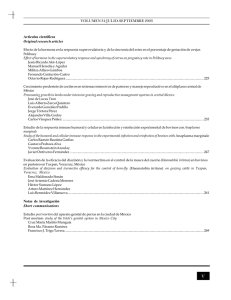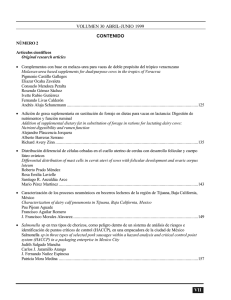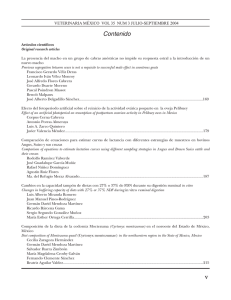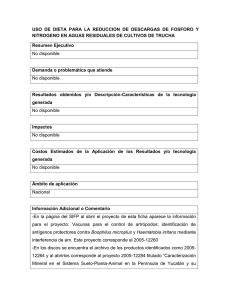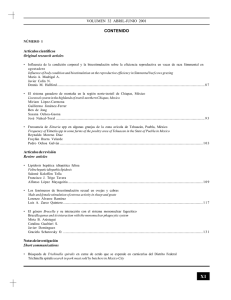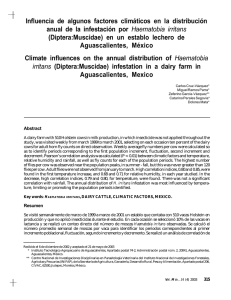rvm39207.pdf
Anuncio
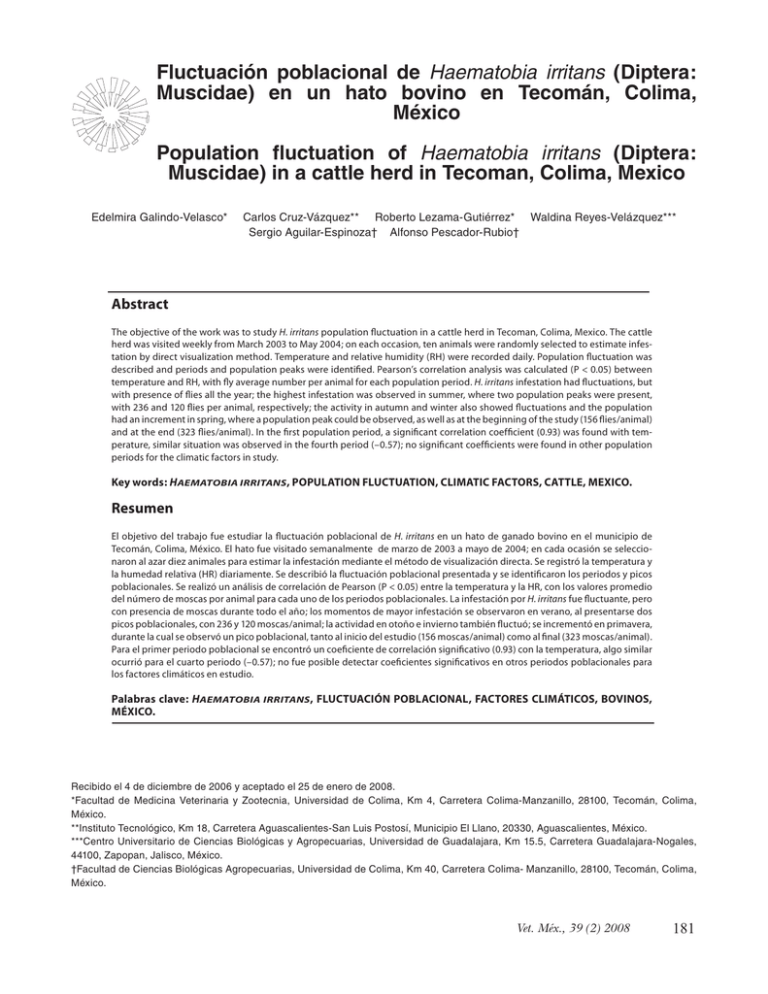
Fluctuación poblacional de Haematobia irritans (Diptera: Muscidae) en un hato bovino en Tecomán, Colima, México Population fluctuation of Haematobia irritans (Diptera: Muscidae) in a cattle herd in Tecoman, Colima, Mexico Edelmira Galindo-Velasco* Carlos Cruz-Vázquez** Roberto Lezama-Gutiérrez* Sergio Aguilar-Espinoza† Alfonso Pescador-Rubio† Waldina Reyes-Velázquez*** Abstract The objective of the work was to study H. irritans population fluctuation in a cattle herd in Tecoman, Colima, Mexico. The cattle herd was visited weekly from March 2003 to May 2004; on each occasion, ten animals were randomly selected to estimate infestation by direct visualization method. Temperature and relative humidity (RH) were recorded daily. Population fluctuation was described and periods and population peaks were identified. Pearson’s correlation analysis was calculated (P < 0.05) between temperature and RH, with fly average number per animal for each population period. H. irritans infestation had fluctuations, but with presence of flies all the year; the highest infestation was observed in summer, where two population peaks were present, with 236 and 120 flies per animal, respectively; the activity in autumn and winter also showed fluctuations and the population had an increment in spring, where a population peak could be observed, as well as at the beginning of the study (156 flies/animal) and at the end (323 flies/animal). In the first population period, a significant correlation coefficient (0.93) was found with temperature, similar situation was observed in the fourth period (–0.57); no significant coefficients were found in other population periods for the climatic factors in study. Key words: HAEMATOBIA IRRITANS , POPULATION FLUCTUATION, CLIMATIC FACTORS, CATTLE, MEXICO. Resumen El objetivo del trabajo fue estudiar la fluctuación poblacional de H. irritans en un hato de ganado bovino en el municipio de Tecomán, Colima, México. El hato fue visitado semanalmente de marzo de 2003 a mayo de 2004; en cada ocasión se seleccionaron al azar diez animales para estimar la infestación mediante el método de visualización directa. Se registró la temperatura y la humedad relativa (HR) diariamente. Se describió la fluctuación poblacional presentada y se identificaron los periodos y picos poblacionales. Se realizó un análisis de correlación de Pearson (P < 0.05) entre la temperatura y la HR, con los valores promedio del número de moscas por animal para cada uno de los periodos poblacionales. La infestación por H. irritans fue fluctuante, pero con presencia de moscas durante todo el año; los momentos de mayor infestación se observaron en verano, al presentarse dos picos poblacionales, con 236 y 120 moscas/animal; la actividad en otoño e invierno también fluctuó; se incrementó en primavera, durante la cual se observó un pico poblacional, tanto al inicio del estudio (156 moscas/animal) como al final (323 moscas/animal). Para el primer periodo poblacional se encontró un coeficiente de correlación significativo (0.93) con la temperatura, algo similar ocurrió para el cuarto periodo (–0.57); no fue posible detectar coeficientes significativos en otros periodos poblacionales para los factores climáticos en estudio. Palabras clave: HAEMATOBIA IRRITANS , FLUCTUACIÓN POBLACIONAL, FACTORES CLIMÁTICOS, BOVINOS, MÉXICO. Recibido el 4 de diciembre de 2006 y aceptado el 25 de enero de 2008. *Facultad de Medicina Veterinaria y Zootecnia, Universidad de Colima, Km 4, Carretera Colima-Manzanillo, 28100, Tecomán, Colima, México. **Instituto Tecnológico, Km 18, Carretera Aguascalientes-San Luis Postosí, Municipio El Llano, 20330, Aguascalientes, México. ***Centro Universitario de Ciencias Biológicas y Agropecuarias, Universidad de Guadalajara, Km 15.5, Carretera Guadalajara-Nogales, 44100, Zapopan, Jalisco, México. †Facultad de Ciencias Biológicas Agropecuarias, Universidad de Colima, Km 40, Carretera Colima- Manzanillo, 28100, Tecomán, Colima, México. Vet. Méx., 39 (2) 2008 181 Introduction Introducción T a mosca del cuerno, Haematobia irritans (L.), es un ectoparásito hematófago de amplia distribución en América; en México se le encuentra en regiones de clima tropical, templadas y semiáridas.1-4 Las altas infestaciones por H. irritans provocan pérdidas en la producción de carne y leche, además de que daña las pieles.5-8 El control ejercido sobre este ectoparásito ha sido principalmente aplicando insecticidas, lo cual puede llevar a la aparición de poblaciones resistentes, como ya ha sucedido en diversas regiones ganaderas de México y otros países, además del problema que significan los residuos de los insecticidas en carne y leche, así como en el medio ambiente.9-11 Esta situación plantea la necesidad de desarrollar métodos alternativos de control no químico; sin embargo, para llevarlos al campo es muy importante comprender la dinámica poblacional de la infestación en la región en donde se pretenda instrumentar alguna de estas alternativas de control, con la finalidad de hacer un uso eficiente y sustentable del recurso. El objetivo del presente estudio fue analizar la fluctuación poblacional de H. irritans en un hato de ganado bovino en el municipio de Tecomán, Colima, México, durante 14 meses, e identificar la influencia de la temperatura y la humedad relativa. he horn fly, Haematobia irritans (L.), is a hematophagous ectoparasite widely distributed in America; in Mexico it has been found in tropical, temperate and semiarid regions.1-4 High infestations by H. irritans cause loss in beef and milk production and damages hides.5-8 Control that is carried out for this ectoparasite has mainly been applying insecticides, which in turn can cause the rising of resistant populations, as has already occurred in several livestock rearing areas of Mexico and other countries. Likewise, this problem signifies insecticide residues in beef and milk as well as the environment.9-11 This situation establishes the need to develop alternative non-chemical control methods; yet to take them to the field it is important that population dynamics of infestation in the region, where any of the control alternatives is to be applied, with the purpose of having an efficient and sustainable use of such control. The objective of this study was to analyze population fluctuation of H. irritans in a cattle herd in Tecoman municipality Colima, Mexico, during 14 months and identify the influence of temperature and relative humidity. L Materials and methods Material y métodos The study was carried out in a cattle ranch in Tecoman, Colima, Mexico, located at 18º 56’ 18’’ North latitude and 103º 56’ 45’’ West longitude, at 30 masl. This municipality has a warm sub-humid climate with mean annual rainfall of 484.9 mm, concentrated mainly in summer.12 The herd was formed by 80 dams Indo-brazil type and Zebu crossed with American Swiss, in a ranging extensive production system, subjected to milking except during the rainy season. The herd was visited weekly from March 2003 to May 2004; on each occasion, 10 animals were randomly selected to estimate infestation by the method of direct observation. Observations were carried out between 8:00 and 10:00 hours, with the aid of a digital counter. Counting covered the regions of head, neck, back, sides and limbs of only one side; the data that was obtained was multiplied by two to obtain an estimate of the total amount of flies.2,13 Temperature and relative humidity (RH) were recorded daily using equipment,* where automatically these values are recorded and transferred to a computer program to retrieve the data, with which weekly means of both climatic parameters were estimated during the study period. Information was analyzed to estimate the weekly 182 El estudio se desarrolló en un rancho ganadero en Tecomán, Colima, México, ubicado a 18º 56’ 18’’ latitud Norte y 103º 56’ 45’’ longitud Oeste, a 30 msnm. El municipio cuenta con clima cálido subhúmedo con precipitación media anual de 484.9 mm, que se concentran en el verano.12 El hato estaba integrado por 80 vacas vientre, de tipo Indobrasil y cruza de Cebú por Suizo Americano, mantenidas en un sistema de producción extensivo en agostadero, sometidas a ordeña, excepto en la temporada de lluvias. El hato fue visitado semanalmente de marzo de 2003 a mayo de 2004; en cada ocasión se seleccionaron al azar diez animales, para estimar la infestación mediante el método de visualización directa; las observaciones se realizaron entre las 8:00 y las 10:00 horas, con el auxilio de un contador digital. El conteo comprendió la región de la cabeza, cuello, dorso, costados y extremidades, por un solo lado del animal; el dato obtenido se multiplicó por dos para tener la estimación del total de moscas.2,13 Se registró la temperatura y la humedad relativa (HR) diariamente, utilizando un equipo*, en el que de manera automática se registran estos valores, los *Data Logger Hobo, Onset Computer, Estados Unidos de América. average number of flies per animal, which was used to describe population fluctuation that occurred during the study period and identify population peaks and periods.2 A Pearson’s correlation analysis was carried out (P < 0.05) between temperature and RH with the average values of flies per animal during each detected population period, through the CORR procedure of the program SAS/STAT v. 9.0.14 Results H. irritans infestation was found to be present during all the study, and three population peaks were identified; with four population activity periods (Figures 1 and 2). The first period began on the 22nd of March and ended with the presentation of the first population peak on the 29th of April 2003, with 156 flies per animal; during this period that coincides with spring, the average temperature was 35°C, the highest of the study and with RH of 74%. The second period started on the 6 th of May and ended with the second population peak on the 13th of July, with 236 flies per animal; in this period, coinciding with summer, the average temperature was 31°C and RH was 71%. The third period began on the 20th of July and ended on the 7th of September, when the third population peak was observed with 120 flies per animal which happened at the end of summer, with an average temperature of 28°C and RH of 84%, the highest of the study. The fourth period was the longest, from the 14th of September 2003 to 27th of March 2004, when population increases and decreases were observed during autumn and winter. From February 2004 on, a popu350 40 300 35 Resultados Se encontró que la infestación por H. irritans se presentó durante todo el estudio, y se identificaron tres picos poblacionales; asimismo, se detectaron cuatro periodos de actividad poblacional (Figuras 1 y 2). El primer periodo inició el 22 de marzo y terminó con la presentación del primer pico poblacional el 29 de abril de 2003, con 156 moscas por animal, en este periodo, coincidente con la primavera, la temperatura promedio fue de 35°C, la más alta del estudio, y con HR de 74%. El segundo periodo comenzó el 6 de mayo y finalizó con el segundo pico poblacional el 13 de julio, con 236 moscas por animal, en este lapso, coincidente con el verano, la temperatura promedio fue de 31°C y la HR de 71%. El tercer periodo inició el 20 de julio y terminó el 7 de septiembre, al observarse el tercer pico poblacional, con 120 moscas por animal, que fue al final del verano, con temperatura 350 100 90 300 30 15 100 10 50 5 0 0 70 60 200 50 150 40 30 100 Relative Humidity (%) 20 150 250 Flies per animal 25 200 80 Temperature °C 250 Flies per animal cuales se trasladan a un programa de cómputo para recuperar los datos, con los cuales se calcularon las medias semanales de ambos parámetros climáticos durante el periodo de estudio. La información se analizó para calcular el número promedio semanal de moscas por animal, que se utilizó para describir la fluctuación poblacional presentada durante el tiempo de estudio, e identificar los periodos y picos poblacionales.2 Se realizó un análisis de correlación de Pearson (P < 0.05) entre la temperatura y HR con los valores promedio del número de moscas por animal para cada periodo poblacional detectado, mediante el procedimiento CORR del programa SAS/STAT v. 9.0.14 Study w eeks Flies per animal 10 0 0 22 /0 3/ 15 200 3 /0 4/ 06 200 /0 3 5/ 24 200 /0 3 5/ 15 200 /0 3 6/ 06 200 /0 3 7/ 27 200 /0 3 7/ 17 200 /0 3 8/ 2 0 07 /0 03 9/ 28 200 /0 3 9/ 31 200 /1 3 0/ 28 200 /1 3 1/ 23 200 /1 3 2/ 11 200 /0 3 1/ 07 200 /0 4 2/ 28 200 4 /0 2/ 17 200 /0 4 3/ 11 200 /0 4 4/ 02 200 /0 4 5/ 20 04 22 /0 3/ 22 200 3 /0 4/ 18 200 3 /0 5/ 15 200 3 /0 6/ 13 200 3 /0 7/ 10 200 3 /0 8/ 07 200 3 /0 9/ 05 200 3 /1 0/ 20 200 3 /1 1/ 23 200 3 /1 2/ 18 200 3 /0 1/ 22 200 4 /0 2/ 17 200 4 /0 3/ 18 200 4 /0 4/ 20 04 20 50 S t u d y we e k T oC Flies per animal RH Figura 1: Fluctuación poblacional de H. irritans en un hato de ganado bovino en Tecomán, Colima, México, en relación con la humedad relativa; periodo marzo 2003-mayo 2004. Figura 2: Fluctuación poblacional de H. irritans en un hato de ganado bovino en Tecomán, Colima,México, en relación con la temperatura; periodo marzo 2003-mayo 2004. Figure 1: Population fluctuation of H. irritans in a cattle herd in Tecoman, Colima, Mexico, in relation to relative humidity; period March 2003- May 2004. Figure 2: Population fluctuation of H. irritans in a cattle herd in Tecoman, Colima, Mexico, in relation to temperature; period March 2003-May 2004. Vet. Méx., 39 (2) 2008 183 lation increase was observed that ended in April with a peak of 323 flies per animal, which corresponded to the new population cycle; this period was characterized by lower temperatures (average 26°C) and moderate RH (77%). In Table 1 the Pearson correlation indexes that were statistically significant (P < 0.05) are observed for each one of the four population periods. For the first one a significant coefficient with temperature was found (r = 0.93), a similar situation happened for the fourth period (r = –0.57); It was not possible to detect statistically significant coefficients for neither temperature nor RH in other population periods. Discussion In this Mexican Pacific geographical area, infestations by H. irritans in the herd under study were found to be fluctuating with the presence of flies during all the year; the highest infestation periods were observed in summer when two population peaks were detected. Activity in autumn and winter also fluctuated but it was increased in a very important amount during spring, with a population peak at the beginning and at the end of the study as well; infestation did not show diapauses during winter. In other tropical regions, H. irritans infestations showed a similar behavior as that which was observed promedio de 28°C y HR de 84%, la más alta del estudio. El cuarto periodo resultó el más largo, del 14 de septiembre de 2003 al 27 de marzo de 2004, cuando se observaron ascensos y descensos poblacionales durante otoño e invierno. A partir de febrero de 2004 se observó incremento poblacional que culminó en abril con pico de 323 moscas por animal, que correspondió al nuevo ciclo poblacional; el periodo se caracterizó por menores temperaturas (promedio 26°C) y moderada HR (77%). En el Cuadro 1 se presentan los índices de correlación de Pearson, que fueron estadísticamente significativos (P < 0.05), para cada uno de los cuatro periodos poblacionales. Para el primero se encontró un coeficiente significativo con la temperatura (r = 0.93), situación similar ocurrió para el cuarto periodo (r = –0.57); no fue posible detectar coeficientes estadísticamente significativos para la temperatura ni para la HR en otros periodos poblacionales. Discusión En esta área geográfica del Pacífico mexicano, la infestación por H. irritans en el hato bajo estudio fue fluctuante y con presencia de moscas durante todo el año; los momentos de mayor infestación se observaron en verano, cuando se presentaron dos picos poblacionales. La actividad en otoño e invierno también Cuadro 1 COEFICIENTES DE CORRELACIÓN (r) DE PEARSON CON SIGNIFICANCIA ESTADÍSTICA (P < 0.05) ENTRE LA TEMPERATURA PROMEDIO (T) Y HUMEDAD RELATIVA PROMEDIO (HR) Y EL NÚMERO PROMEDIO DE MOSCAS Haematobia irritans POR ANIMAL, EN LOS CUATRO PERIODOS POBLACIONALES IDENTIFICADOS EN UN HATO DE GANADO BOVINO EN TECOMÁN, COLIMA, MÉXICO PEARSON’S CORRELATION COEFFICIENTS (r) WITH STATISTICAL SIGNIFICANCE (P < 0.05) BETWEEN AVERAGE TEMPERATURE (T) AND AVERAGE RELATIVE HUMIDITY (RH) AND AVERAGE NUMBER OF Haematobia irritans FLIES PER ANIMAL, DURING THE FOUR POPULATION PERIODS IDENTIFIED IN A CATTLE HERD IN TECOMAN, COLIMA, MEXICO Dates Population periods (day/month/year) T (°C) RH (%) 1 22/03 to 29/04/2003 0.93 ns 2 06/05 to 13/07/2003 ns ns 3 20/07 to 07/09/2003 ns ns 4 14/09/2003 to 27/03/2004 – 0.57 ns ns = non significant 184 in Tecoman, where flies can be detected during the four seasons of the year, without a clear cut of activity in population curves as could be observed.3,15,16 In contrast, in regions of temperate climate it is evident that winter season marks a reduction of population activity linked to low temperatures.2,17 Climatic conditions in the study site showed an average temperature of 28°C and 74% RH, that are favorable for the development of H. irritans. This situation explains the observed population fluctuations; 18,19 in another study the non-diapausic cycle is related to temperatures between 23°C and 30°C, values similar to the ones detected in the study site.20 In other studies carried out in tropical regions as well as temperate climate ones, bimodal population curves with peaks in spring-summer or summer-end of autumn have been detected; 2,4,15,16,21 nevertheless, in Soto la Marina, Tamaulipas, Mexico, the presence of three population peaks and important fluctuations during the year have been indicated, as it has been in this study, 3 events that are attributed to warm and humid climatic conditions that are predominant in both regions of the Mexican tropic during most of the year, and this indicates that fly season in the study site is ample with constant fluctuations. Abundance of H. irritans flies observed all along the population fluctuations was manifested with values of 156, 236 and 120 flies per animal, that must be considered as high; although the first peak of the new cycle in April 2004, had 323 flies per animal; population abundance has an annual average of 150 flies per animal. Literature reports indicate that the economic threshold is reached in infestations above 200 flies,1 value that is reached in this study during summer, when humidity and temperature combine to favor important population growth. Nevertheless, other studies mention that temperature is the most important climatic factor to begin population growth in spring.2,4,15,17,18 In this study, this fact is also documented since a statistically significant correlation with temperature was detected at the beginning of the study (first population period, beginning of spring). This correlation was also detected, but with negative sign during the fourth population period (that mainly covered autumn and winter), during which temperatures fell and this had an impact on the population that had a decreasing tendency, although there were constant fluctuations. Finally, there was a population increase corresponding to the new cycle that ended with a peak in April 2004, in spring, and this was the highest of the study above the economic threshold mentioned above. Those results allow to conclude that infestation by H. irritans in the study site is continuous during all the year, it has constant fluctuations and three population fluctuó, pero se incrementó de manera importante en la primavera, al observarse un pico poblacional tanto al inicio como al final del estudio; la infestación no presentó diapausa en el invierno. En otras regiones tropicales, la infestación por H. irritans mostró un comportamiento similar al observado en Tecomán, en donde se detectan moscas durante las cuatro estaciones del año, sin que sea posible identificar un corte claro de actividad en la curva poblacional.3,15,16 En contraste, en regiones de clima templado es evidente que la estación de invierno marca una disminución de actividad poblacional ligada a las bajas temperaturas.2,17 Las condiciones climáticas en el sitio de estudio mostraron temperatura promedio de 28°C y 74% de HR, que favorecen el desarrollo de H. irritans, situación que explica las fluctuaciones poblacionales observadas; 18,19 en otro estudio se ha observado que el ciclo no diapaúsico se relaciona con la temperatura, entre 23°C y 30°C, valores similares a los detectados en el sitio de estudio.20 En otros trabajos realizados tanto en regiones tropicales como de clima templado, se ha detectado una curva poblacional bimodal con picos en primavera-verano o en verano-final del otoño; 2,4,15,16,21 sin embargo, en Soto la Marina, Tamaulipas, México, se señala la presencia de tres picos poblacionales y fluctuaciones importantes en el año, como en este estudio, 3 evento atribuible a las condiciones climáticas cálidas y húmedas predominantes en ambas regiones del trópico mexicano durante la mayor parte del año, lo que permite considerar que la temporada de moscas en el sitio de estudio es amplia y con fluctuaciones constantes. La abundancia de moscas H. irritans observada a lo largo de las fluctuaciones poblacionales, se manifestó con valores de 156, 236 y 120 moscas por animal, que deben considerarse moderadamente elevados; aunque el primer pico del nuevo ciclo, en abril de 2004, tuvo 323 moscas por animal; la abundancia poblacional tuvo un promedio anual de 150 moscas por animal. En la literatura se informa que el umbral económico se sitúa en infestaciones por arriba de 200 moscas,1 valor alcanzado en este estudio durante el verano, cuando se combinan humedad y temperatura para propiciar un crecimiento poblacional importante; sin embargo, otros estudios mencionan que la temperatura es el factor climático más importante para iniciar el crecimiento poblacional en primavera.2,4,15,17,18 En el presente estudio también se documenta este hecho, ya que se detectó correlación estadísticamente significativa con la temperatura al inicio del estudio (primer periodo poblacional, inicio de la primavera). También se detectó esta correlación, pero de signo negativo, en el cuarto periodo poblacional (que abarcó principalmente el otoño e invierno), durante el cual Vet. Méx., 39 (2) 2008 185 abundance peaks, that can reach levels that harm production. This information can give elements to propose strategies for the integral control of this pest in the zone, that may allow a sustainable use of available resources avoiding the increase of resistance to insecticides. Referencias 1. Foil LD, Hogsette JA. Biology and control of tabanids, stable flies and horn flies. Rev Sci Tech 1994;13:11251158. 2. Guglielmone AA, Anziani OS, Mangold AJ, Giorgi RE, Volpogni MM, Flores SG. Seasonal variation of Haematobia irritans (Diptera:Muscidae) in recently infested region of central Argentina. Bull Entomol Res 1997;87:55-59. 3. Almazán GC, Castillo SS, Loredo OJ, García-Vázquez Z. Dinámica poblacional de Haematobia irritans en un hato de bovinos de Soto la Marina, Tamaulipas, México. Vet Méx 2001;32:149-152. 4. Cruz-Vázquez C, Bautista HJ, Vitela MI, Ramos PM, Quintero MMT, García-Vázquez Z. Distribución anual de Haematobia irritans (L.) (Diptera:Muscidae) en tres establos lecheros de Aguascalientes, México. Vet Méx 2000;31:195-199. 5. Haufe WO. Host-Parasite interaction of blood feeding dipterans in health and productivity of mammals. Int J Parasitol 1987;17:607-614. 6. Byford RL, Craig ME, Crosby BL. A review of ectoparasites and their effect on cattle production. J Anim Sci 1992;70:597-602. 7. Morrison DG, Foil LD. Effect of horn fly (Diptera:Muscidae) control during the spring on calf production by fall-calving beef cows. J Econ Entomol 1995;88:81-84. 8. Guglielmone AA, Gimeno E, Ediart J, Fisher WF, Volpogni MM, Quaino O et al. Skin lesions and cattle hide damage from Haematobia irritans infestations. Med Vet Entomol 1999;13:324-329. 9. Kunz SE, Kemp DH. Insecticides and acaricides: Resistance and environmental impact. Rev Sci Tech 1994;13:1249-1286. 10. Kunz SE, Ortiz-Estrada M, Fragoso-Sánchez H. Status of Haematobia irritans (Diptera:Muscidae) insecticide resistance in northeastern Mexico. J Med Entomol 1995;32:726-729. 11. Martinez IF, Osorio MJ, Ortiz NA, Fragoso SH, Giles HI. Current situation of pyrethroid resistance in the horn fly Haematobia irritans in ten Mexican states. In: Proceedings V International Seminar in Animal Parasitology; 2003 October 1-3; Merida (Yuc) Mexico. Mexico (DF): Secretaría de Agricultura, Ganadería, Desarrollo Rural y Pesca, 2003:231-239. 186 la temperatura disminuyó, lo que tuvo un impacto en la población, que tendió al decremento, aunque presentó fluctuaciones constantes. Finalmente, hubo un incremento poblacional, correspondiente a un nuevo ciclo, que culminó con un pico en abril de 2004, en primavera, y que resultó el más alto del estudio, por arriba del umbral económico ya mencionado. Esos resultados permiten concluir que la infestación por H. irritans en el sitio de estudio es continua durante todo el año, presenta fluctuaciones constantes y tres picos de abundancia poblacional, los cuales pueden alcanzar niveles que provocan daño a la producción. Esta información puede aportar elementos para proponer estrategias de control integrado en la zona, que permitan un manejo sustentable de los recursos disponibles y eviten el aumento de la resistencia a los insecticidas. 12. INEGI. Anuario Estadístico del estado de Colima. Colima:Instituto Nacional de Estadística, Geografía e Informática, Gobierno del estado de Colima, 2000. 13. Lima LGM, Prado AP, Perri SHV. Comparison of two methods (visual estimates and filming) for counts of horn flies (Haematobia irritans) (L.) (Diptera:Muscidae). Vet Parasitol 2002;103:227-235. 14. Statistical Analysis System. SAS user’s guide: statistics. Cary (NC):SAS Institute, 1988. 15. Barros ATM. Dynamics of Haematobia irritans (Diptera: Muscidae) infestation on Nelore cattle in the Pantanal, Brazil. Mem Inst Oswaldo Cruz 2001;96:445-450. 16. Maldonado-Siman E, Bermudez VL, Cadena MJ, Sumano LH, Kunz SE. Seasonal fluctuation of Haematobia irritans (Diptera:Muscidae) on beef cattle in Tuxpan, Veracruz, Mexico. African Entomol 2004;12:125-129. 17. Cruz-Vázquez C, Ramos PM, García-Vázquez Z, Perales SC, Mata D. Influencia de algunos factores climáticos en la distribución anual de la infestación por Haematobia irritans (Diptera:Muscidae) en un establo lechero de Aguascalientes, México. Vet Méx 2003;34:315-322. 18. Lysyk TJ, Moon RD. Diapause induction in the horn fly (Diptera:Muscidae). Environ Entomol 1994;28:387397. 19. Perotti MA, Lysyk TJ. Novel growth media for rearing larval horn flies, Haematobia irritans (Diptera:Muscidae). J Med Entomol 2003;40:22-29. 20. Barros ATM. Desenvolvimento de Haematobia irritans em massas fecais de bovinos mantidas no laboratorio. Pesq Agrop Bras 2002;37:217-221. 21. Kunz SE, Cunninham JR. A population prediction equation with notes on the biology of the horn fly in Texas. Southwest Entomol 1977;2:79-87. Estudio de la consolidación ósea en rata por microscopía electrónica de barrido ambiental Study on the osseous consolidation in rat by environmental scanning electron microscopy Rosario Neri Basurto* Lilia Solís Arrieta* Hilda Villegas Castrejón* Abstract The environmental scanning electron microscope (ESEM) has been recently applied to orthopedics, for which a study was performed on the modes of operation of this electron microscope. Optimal conditions were determined to obtain the best topographic image and to perform chemical analysis by X-ray dispersion during the process of bone consolidation. Fifteen male Wistar rats were used, grouped in three per each experimental day. Tibial fracture was provoked and a Kirschner wire was positioned. Rats were euthanized 0 (control), 7, 14, 21 and 28 days after surgery. According to the results, the best bone image was observed with retrodispersed electrons under high vacuum. In the chemical element determination lower variation coefficients were obtained under low vacuum for carbon and calcium; for phosphorus, under high vacuum, and in environmental mode, for magnesium, sodium, potassium and iron. In the process of bone consolidation, calcium levels in cortical bone diminished compared to controls, while the calcified bone callus was observed until day 14. Phosphorus concentration increased with time, in both cortical bone and bone callus. Magnesium presented a peak on day 14, and decreased drastically until day 28. Sodium rose continuously until day 28. The study of the chemical composition of bone by the ESEM is optimal in the environmental mode, since values of the elements present in lesser concentrations (1%) showed a lower variation coefficient. In bone consolidation process, calcium and phosphorus levels were found at a ratio of 2:1. Key words: BONE COSOLIDATION, BONE ENVIROMENTAL SCANNING ELECTRON MICROSCOPY, BONE CHEMICAL ANALYSIS. Resumen La aplicación del microscopio electrónico de barrido ambiental (ESEM) en ortopedia no se había desarrollado hasta ahora, por lo que se realizó un estudio sobre los modos de operación del microscopio electrónico; así se determinaron las condiciones óptimas de obtención de la mejor imagen topográfica y del análisis químico por dispersión de rayos X durante el proceso de la consolidación ósea. Para ello se utilizaron 15 ratas macho de la cepa Wistar, que se agruparon en tres por cada día experimental, se les produjo una fractura en la tibia y se les colocó un alambre Kirschner; se efectuó eutanasia a los 0 (testigo), 7, 14, 21 y 28 días después de la cirugía. De acuerdo con los resultados, la mejor imagen del hueso se observó con electrones retrodispersados en alto vacío. En la determinación de elementos químicos se obtuvieron los menores coeficientes de variación en bajo vacío para carbono y calcio; en alto vacío, para fósforo, y en modo ambiental, para magnesio, sodio, potasio y fierro. En el proceso de la consolidación ósea los niveles de calcio en hueso cortical disminuyeron en comparación con el testigo, mientras que el callo óseo calcificado se observó hasta el día 14. La concentración de fósforo incrementó con el tiempo, tanto en hueso cortical como en callo óseo. El magnesio presentó un pico el día 14 y bajó drásticamente hasta el día 28; por último, el sodio subió de manera sostenida hasta el día 28. El mejor modo de estudiar la composición química del hueso en el ESEM es el modo ambiental, pues los valores de los elementos que están en menor concentración (1%) presentaron coeficiente de variación más bajo. En el proceso de consolidación ósea, los niveles de calcio y fósforo se encontraron en relación 2:1. Palabras clave:CONSOLIDACIÓN ÓSEA, MICROSCOPÍA ELECTRÓNICA DE BARRIDO AMBIENTAL DE HUESO, ANÁLISIS QUÍMICO EN HUESO. Recibido el 6 de diciembre de 2006 y aceptado el 29 de febrero de 2008. *Servicio de Morfología Celular y Molecular, Instituto Nacional de Rehabilitación, Calzada México-Xochimilco 289, Col. Arenal de Guadalupe, Tlalpan, 14389, México, D. F., Tel. 5999-1000, ext. 19107, Fax: 5603-9197, correo electrónico: [email protected] Correspondencia: Rosario Neri Basurto, Servicio de Morfología Celular y Molecular, Instituto Nacional de Rehabilitación, Calzada MéxicoXochimilco 289, Col. Arenal de Guadalupe, Tlalpan, 14389, México, D. F. Vet. Méx., 39 (2) 2008 187
